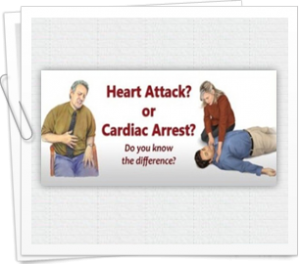Online CPR Certification Blog
Difference between cardiac arrest and heart attack
Date: April 27th, 2014
 Heart attacks and cardiac arrest ate two distinct cardiac events despite both being very seriously hazardous to the health. Cardiac arrests occur when the heart stops beating due to a malfunction if the organ itself. This results in a person losing consciousness. Heart attacks on the other hand happen occur when there is very little blood flowing into the heart.
Heart attacks and cardiac arrest ate two distinct cardiac events despite both being very seriously hazardous to the health. Cardiac arrests occur when the heart stops beating due to a malfunction if the organ itself. This results in a person losing consciousness. Heart attacks on the other hand happen occur when there is very little blood flowing into the heart.
Analyzing heart attacks and cardiac arrest
The scientific or of medical term for a heart attack is MI (myocardial infarction). It occurs when blood supply to heart muscles is cut off due to atherosclerosis. This is the formation of a plaque that consists of fat lodged inside the arteries responsible for carrying oxygenated blood to the heart.
The symptoms of a heart attack include difficulty in breathing, radiating pain and pains in the chest. You might also experience other symptoms such as cold sweat, dizzy spells, nausea and stomach pain.
Cardiac arrests are caused by electric pulses. The result is an irregular heart beat better known as arrhythmia. This can prevent your heart from pumping enough blood or worse case scenario; it can make your heart stop completely. Heart attacks can cause cardiac arrest though the reverse is necessarily not true. Diseases that can result in cardiac arrests include damage to the heart muscles or heart failure. A person often loses consciousness during a sudden cardiac event. They won’t be able to breathe and their pulse is often very weak or non-existent.
Responding to a heart attack and cardiac arrest
Both cardiac arrests and heart attacks are considered incidents that are fatal if no treated immediately. One of the best ways to respond is to call 911 especially if you have no knowledge or skill that can help save the life of the victim. Paramedics will be best suited to handle the situation on arrival and that’s why you should call them immediately. They also have the equipment which will facilitate the treatment process. Some of the devices that they use include AEDs (Automatic external defibrillators).
Hands only chest compression is the best procedure to administer for a person suffering from a cardiac arrest. This technique significantly increases the survival rate of the victim and also prevents them from neurological damage. You should start by checking their breathing pattern. Commence CPR if they aren’t responding to your call or not breathing. Use AEDs if available or continue with CPR until the victim responds or the paramedics arrive.
Heart attack survivals mostly depend on their severity. They are also heavily reliant on the treatment method used and rate at which action is taken. You shouldn’t wait past five minutes to call for help when you start having a heart attack as it can be too late for you to get saved by then. Calling for help immediately will stand as your best chance to increase your survival rates. Knowing the difference between the two events can also help you identify the right treatments.
